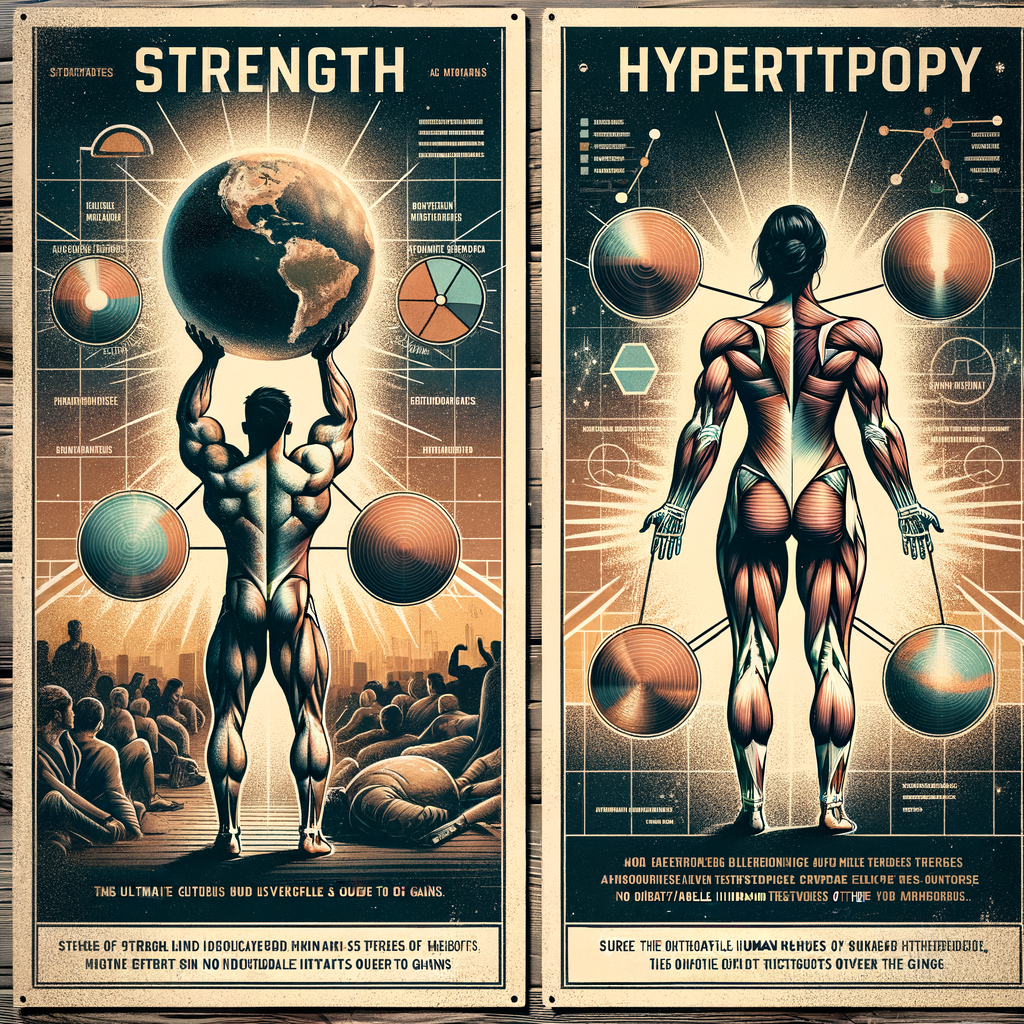- Understanding Strength and Hypertrophy: The Basics
- The Science Behind Strength Development
- Hypertrophy: Understanding Muscle Growth
- Training Programs: Strength vs. Hypertrophy
- Nutrition Considerations for Strength and Hypertrophy
- Common Myths: Debunking Misconceptions
- Integrating Both Approaches for Optimal Results
- Monitoring Progress: Strength vs. Hypertrophy
- Choosing the Right Approach for Your Goals
- Frequently Asked Questions
- References
Understanding Strength and Hypertrophy: The Basics
When it comes to fitness, strength and hypertrophy are two popular goals that many individuals strive for. Each represents a different area of focus, and understanding the distinctions can significantly influence your training approach. In essence, strength relates to the maximum amount of force your muscles can produce. On the other hand, hypertrophy deals with increasing the size of your muscle fibers. While they often overlap, your training program can emphasize either one.
Let’s start with strength. Strength training typically involves heavy weights and lower repetitions. This approach activates your body’s neurological pathways, improving how efficiently your muscles communicate. Practicing heavy lifts can enhance overall body mechanics and performance in daily activities. As you become stronger, lifting heavier weights becomes more manageable, leading to continual progress.
Hypertrophy, in contrast, focuses on muscle size. Typically, this involves moderate weights with higher repetitions. This type of training creates micro-tears in your muscle fibers. As these tears heal, your muscle size increases. Bodybuilders frequently use hypertrophy methods to achieve the impressive physiques associated with their sport.
The Science Behind Strength Development
Strength is about more than just muscle size. It’s a complex interplay of various factors, including muscle fibers, neuromuscular adaptations, and even hormonal influences. Muscle fibers fall into two primary categories: slow-twitch and fast-twitch. Slow-twitch fibers are excellent for endurance, while fast-twitch fibers are vital for strength and power.
Neuromuscular adaptations play a key role in building strength. When you start lifting weights, your body undergoes significant changes. Your nervous system learns how to recruit muscle fibers more effectively. Over time, you develop better coordination and increased efficiency in your movements. This means that even without increasing muscle size, you can lift heavier weights because your body has become more adept at using its existing muscle fibers.
Hormones like testosterone and growth hormone also impact strength. They facilitate muscle recovery and adaptation, aiding in muscle growth over time. Understanding these biological mechanisms can help you tailor your workouts to maximize strength gains.
Hypertrophy: Understanding Muscle Growth
Hypertrophy results from a combination of mechanical tension, metabolic stress, and muscle damage. Mechanical tension occurs when muscles are engaged against resistance, whether that’s lifting weights or performing bodyweight exercises. This tension activates muscle fibers and signals your body to adapt.
Metabolic stress arises from prolonged exertion while lifting weights, causing a buildup of metabolic byproducts like lactic acid. This stress contributes to the “pump” many people associate with training. Your body responds by increasing blood flow to the muscles, delivering essential nutrients and oxygen.
In addition to mechanical tension and metabolic stress, muscle damage plays a critical role in hypertrophy. During intense workouts, tiny tears form in muscle fibers. As these tears heal, the muscles grow larger and stronger. This is why a well-structured hypertrophy program often includes a variety of exercises and rep ranges. Varying your routine helps target different muscle fibers, facilitating overall growth.
Training Programs: Strength vs. Hypertrophy
When designing a training program, understanding whether your focus is strength or hypertrophy will dictate your methods. For strength, programs often emphasize heavy weights, typically ranging from 80-90% of your one-rep max (1RM). Repetition ranges often fall between 1-6 reps, with longer rest periods of 2-5 minutes between sets to maximize recovery.
Here’s a simple table that outlines typical strength training characteristics:
| Characteristic | Strength Training |
|———————|———————-|
| Weight | 80-90% of 1RM |
| Repetitions | 1-6 |
| Sets | 4-6 |
| Rest Period | 2-5 minutes |
| Frequency | 2-4 times per week |
On the flip side, a hypertrophy program focuses on moderate weights, typically ranging from 60-75% of your 1RM. This training often utilizes higher repetitions (8-12) with shorter rest periods (30-90 seconds) to maintain muscle engagement and maximize metabolic stress.
Here’s a simple table for hypertrophy training:
| Characteristic | Hypertrophy Training |
|———————|———————-|
| Weight | 60-75% of 1RM |
| Repetitions | 8-12 |
| Sets | 3-4 |
| Rest Period | 30-90 seconds |
| Frequency | 3-6 times per week |
Nutrition Considerations for Strength and Hypertrophy
Nutrition plays a vital role in both strength and hypertrophy. While macronutrient needs may vary based on your goals, certain guidelines can maximize your gains. For strength training, focus on stable energy sources, such as complex carbohydrates and healthy fats.
Eating ample protein is crucial for muscle recovery and growth. Aim for around 1.6 to 2.2 grams of protein per kilogram of body weight. This range supports muscle repair and helps optimize strength gains.
In contrast, hypertrophy requires a slightly different focus. You’ll want to consume a caloric surplus to fuel muscle growth efficiently. This means eating more than your body burns on a daily basis. High-quality protein sources, such as lean meats, eggs, and plant-based proteins, become key players in your diet. Don’t overlook the importance of carbohydrates for energy and recovery.
It’s also important to stay well-hydrated. Dehydration can hinder both strength and hypertrophy gains, so maintain good fluid intake before, during, and after workouts.
Common Myths: Debunking Misconceptions
Misunderstandings abound when it comes to training for strength versus hypertrophy. One of the most prevalent myths is that lifting heavy weights builds only strength. In reality, lifting heavy can also promote hypertrophy, especially if you’re working within an adequate rep range.
Another common myth claims that training for hypertrophy automatically leads to unwanted mass gain. While it’s true that increased muscle size occurs, hypertrophy training can improve overall health when combined with an appropriate diet and cardio. Muscle mass does not equate to excessive bulk; it can enhance metabolic function, increase energy expenditure, and improve overall physique.
Additionally, some believe that strength training requires exclusively low repetitions. In truth, strength adaptations can occur across various rep ranges, particularly when practitioners incorporate variations in their training.
Integrating Both Approaches for Optimal Results
While strength and hypertrophy are often seen as distinct goals, integrating both can yield exceptional results. Many athletes and fitness enthusiasts successfully combine aspects of both training styles. This approach fosters all-around fitness and provides performance benefits.
For example, you might structure your week with dedicated strength days and hypertrophy-focused sessions. Start your training week with heavy lifts like deadlifts or squats to build strength. Follow these with accessory work that targets specific muscle groups for hypertrophy.
You might also incorporate periodization into your training. This means cyclically altering your focus between strength and hypertrophy over weeks or months. A well-planned program can prevent stagnation and keep your training sessions engaging.
Monitoring Progress: Strength vs. Hypertrophy
Tracking your progress is pivotal to understanding how your body responds to different training styles. For strength training, keep detailed records of your lifts, noting 1RM improvements, rep ranges, and workout intensity. Periodic testing can help you identify when it’s time for adjustments.
To monitor hypertrophy progress, consider taking progress photos, measuring muscle circumferences, and tracking weight changes. While the scale can provide insight into overall changes, it may not accurately reflect muscle gains or fat loss. Look for tangible differences in measurements or how clothes fit.
Choosing the Right Approach for Your Goals
Deciding whether to focus on strength or hypertrophy ultimately depends on your personal fitness goals. Those aspiring to lift heavier weights and enhance athletic performance often lean toward strength training. Conversely, if your primary goal is muscle size and aesthetics, a hypertrophy-based program may be more suitable.
Ultimately, many athletes find that incorporating elements of both approaches yields the best overall results. Remember, the journey is yours, and continuously listening to your body will shape your fitness path.
Frequently Asked Questions
1. Can I train for both strength and hypertrophy at the same time?
Yes, combining both training styles can yield balanced results. Many athletes successfully integrate elements of strength and hypertrophy into their routines.
2. How often should I train for strength vs. hypertrophy?
Strength training usually requires 2-4 times per week, while hypertrophy can be done 3-6 times weekly, depending on individual recovery.
3. What is a good protein intake for muscle growth?
Aim for 1.6 to 2.2 grams of protein per kilogram of body weight for optimal muscle recovery and growth.
4. Do I need to eat more calories to gain muscle?
Yes, a caloric surplus is beneficial for hypertrophy, while strength gains can often be achieved with maintenance calories.
5. Is it normal to gain weight during hypertrophy training?
Yes, it’s common to gain some weight due to increased muscle mass and water retention from higher carbohydrate intake.
6. Can women benefit from strength training?
Absolutely! Strength training benefits women by improving bone density, boosting metabolism, and enhancing body composition.
7. How long does it take to see results from strength or hypertrophy training?
Results can vary, but you may start seeing visible changes within 4-8 weeks, assuming a consistent training and nutrition plan.
8. What exercises are best for strength training?
Compound movements like squats, deadlifts, bench presses, and overhead presses are excellent for building strength.
9. Can I train strength and hypertrophy in the same workout?
Yes, many training programs incorporate a mix of strength and hypertrophy exercises in the same session.
10. What role does rest play in strength and hypertrophy?
Recovery is crucial in both training styles. Adequate rest allows muscles to heal and grow, enhancing your performance over time.
References
1. Schoenfeld, B.J. (2010). “Squatting Kinetics and Kinematics.” Journal of Sports Science and Medicine.
2. Krieger, J.W. (2010). “Single vs. Multiple Sets of Resistance Exercise: A Meta-Regression.” Journal of Strength and Conditioning Research.
3. Phillips, S.M., et al. (2009). “Protein Requirements and Supplementation.” Journal of Sports Sciences.
4. Rhea, M.R., & al. (2003). “Multiple Sets Match Single Sets in Trained Women.” Journal of Strength and Conditioning Research.
This guide aims to provide you with a solid foundation on the difference between strength and hypertrophy, fostering educated choices in your training journey.



